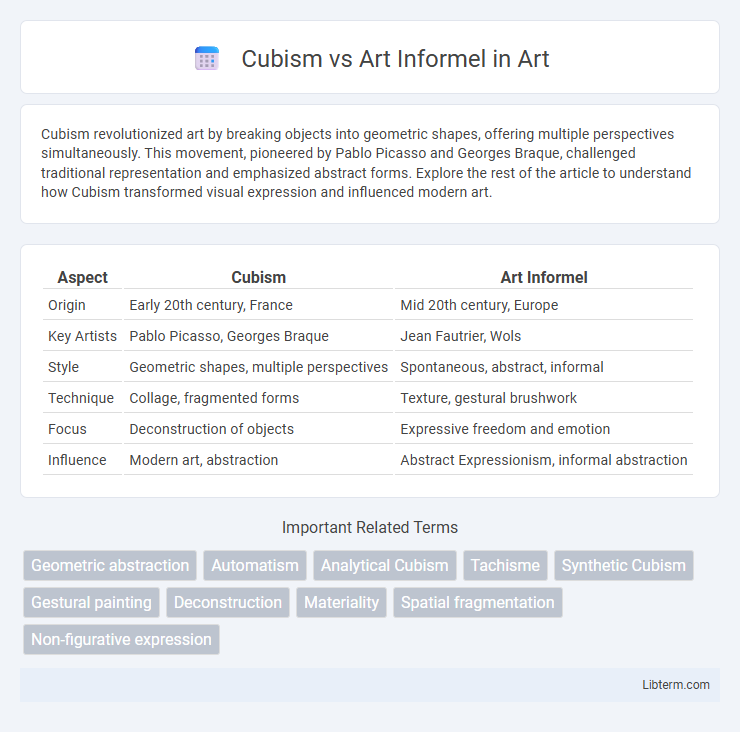Cubism revolutionized art by breaking objects into geometric shapes, offering multiple perspectives simultaneously. This movement, pioneered by Pablo Picasso and Georges Braque, challenged traditional representation and emphasized abstract forms. Explore the rest of the article to understand how Cubism transformed visual expression and influenced modern art.
Table of Comparison
| Aspect | Cubism | Art Informel |
|---|---|---|
| Origin | Early 20th century, France | Mid 20th century, Europe |
| Key Artists | Pablo Picasso, Georges Braque | Jean Fautrier, Wols |
| Style | Geometric shapes, multiple perspectives | Spontaneous, abstract, informal |
| Technique | Collage, fragmented forms | Texture, gestural brushwork |
| Focus | Deconstruction of objects | Expressive freedom and emotion |
| Influence | Modern art, abstraction | Abstract Expressionism, informal abstraction |
Introduction to Cubism and Art Informel
Cubism, pioneered by Pablo Picasso and Georges Braque in the early 20th century, revolutionized art by breaking objects into geometric shapes and presenting multiple viewpoints simultaneously. Art Informel, emerging in post-World War II Europe, emphasized spontaneity and abstract forms, rejecting structured compositions in favor of expressive brushwork and texture. Both movements challenged traditional representation, Cubism through analytical fragmentation and Art Informel through emotional abstraction.
Historical Context and Origins
Cubism emerged in the early 20th century, primarily between 1907 and 1914, pioneered by Pablo Picasso and Georges Braque, as a radical break from traditional perspective and realistic representation, rooted in the rapidly modernizing urban environment of Paris. Art Informel developed post-World War II, during the 1940s and 1950s in Europe, reflecting existentialist philosophies and a reaction against the structured forms of earlier modernism, emphasizing spontaneity and emotional intensity. The historical contexts reveal Cubism's analytical approach amidst industrial progress contrasted with Art Informel's expressive abstraction influenced by wartime trauma and a desire for artistic freedom.
Key Philosophies and Artistic Intentions
Cubism emphasizes fragmented perspectives and geometric forms to depict multiple viewpoints simultaneously, challenging traditional representation of reality. Art Informel prioritizes spontaneity, texture, and emotional expression, rejecting formal structure in favor of intuitive creation. While Cubism seeks analytical deconstruction and intellectual engagement, Art Informel embraces irrationality and the unconscious to convey raw, gestural energy.
Major Influencers and Pioneering Artists
Cubism, pioneered by Pablo Picasso and Georges Braque in the early 20th century, revolutionized art through fragmented forms and multiple perspectives, influencing figures like Juan Gris and Fernand Leger. Art Informel, emerging post-World War II with key artists such as Jean Dubuffet and Wols, emphasized spontaneous, abstract expression and rejected geometric structure, contrasting Cubism's analytical approach. Both movements significantly shaped modern art, with Cubism laying the groundwork for abstraction while Art Informel expanded emotional and gestural freedom.
Distinctive Visual Characteristics
Cubism features fragmented, geometric shapes and multiple viewpoints within a single composition, emphasizing structure and abstraction. Art Informel embraces spontaneous, gestural brushwork with irregular, textured surfaces, focusing on emotional expression and the subconscious. The sharp, analytical forms of Cubism contrast with the organic, chaotic patterns characteristic of Art Informel.
Techniques and Materials Used
Cubism utilizes fragmented geometric shapes and multiple perspectives, often employing oil paints on canvas to create a structured yet abstract representation of subjects. Art Informel emphasizes spontaneous, gestural techniques with materials like industrial paints, sand, and mixed media on rough surfaces to evoke emotion and texture. The contrast lies in Cubism's analytical construction versus Art Informel's emphasis on materiality and expressive freedom.
Artistic Evolution and Periodization
Cubism, emerging in the early 20th century, revolutionized artistic perception through fragmented forms and multiple perspectives, marking a clear break from traditional representation between 1907 and the 1920s. Art Informel, flourishing post-World War II from the 1940s to the 1960s, emphasized spontaneity, texture, and emotional expression, contrasting Cubism's structured approach and reflecting the broader existentialist concerns of its period. The evolution from Cubism to Art Informel illustrates a shift from analytical deconstruction to expressive abstraction, highlighting key transitions in modern art's chronological development.
Impact on Contemporary Art Movements
Cubism revolutionized contemporary art by introducing fragmented perspectives and geometric abstraction, influencing movements such as Futurism and Abstract Expressionism. Art Informel emphasized spontaneous, gestural brushwork and emotional intensity, laying the groundwork for Abstract Expressionism and Tachisme. Both movements challenged traditional aesthetics, shaping modern art's emphasis on individual expression and conceptual innovation.
Critical Reception and Interpretation
Cubism, pioneered by Picasso and Braque, was critically acclaimed for its innovative fragmentation of forms and multiple perspectives, reshaping visual representation in early 20th-century art. In contrast, Art Informel, emerging post-World War II, evoked mixed reviews due to its emphasis on spontaneity, abstraction, and emotional intensity, challenging traditional artistic conventions. Critics often interpreted Cubism as a cerebral, structured approach to reality, while Art Informel was seen as a raw, introspective expression of existential angst.
Conclusion: Enduring Legacies
Cubism revolutionized modern art by fragmenting perspectives and emphasizing geometric abstraction, significantly influencing movements like Futurism and Constructivism. Art Informel, characterized by spontaneous gestures and textured surfaces, challenged traditional formality and paved the way for Abstract Expressionism and Tachisme. Both movements left enduring legacies that reshaped artistic expression by prioritizing innovation and emotional intensity in 20th-century art.
Cubism Infographic

 libterm.com
libterm.com